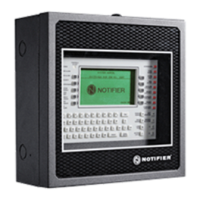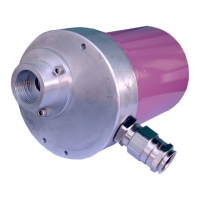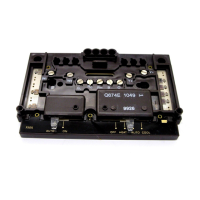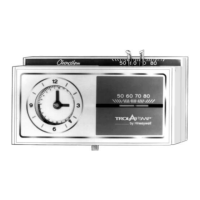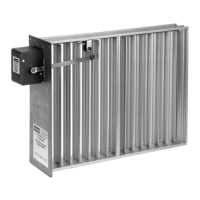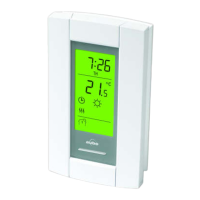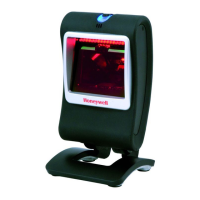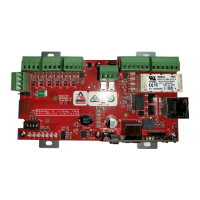Do you have a question about the Honeywell Series A and is the answer not in the manual?
Indicates a situation which, if not avoided, may result in equipment damage or injury.
Indicates a potentially hazardous situation which, if not avoided, could result in serious injury or death.
Summarizes key areas of enhancement for Fieldbus integration into the Experion system.
Illustrates the typical non-redundant Fieldbus architecture using CIOM-A FIM.
Illustrates a redundant Fieldbus architecture using CIOM-A FIMs and Redundancy Modules.
Explains the FIM's role as a bridge for Fieldbus integration and communication.
Describes the Redundancy Module's function in coordinating synchronization for redundant systems.
Explains how Control Builder facilitates integral creation and configuration of Fieldbus and Experion blocks.
Details how the Parameter Definition Editor (PDE) edits function block parameters and its role in interoperability.
Explains how the PDE retrieves method code from DD files and includes a dedicated Methods tab.
Explains data integration handled by FIM, link objects, network management, and system management.
Explains how Control Builder's Type function enables integrating fieldbus function blocks with Experion blocks.
Describes wiring an Analog Input (AI) function block output to a control module input in Control Builder.
Explains how Control Builder handles analog input from fieldbus blocks, mapping data structures and status.
Describes wiring a control module output to an Analog Output (AO) or PID function block in a fieldbus device.
Explains how Control Builder handles analog output and back calculation, mapping parameters and status.
Describes wiring a Discrete Input (DI) function block output to a Device Control (DEVCTL) function block.
Explains how Control Builder handles discrete input from fieldbus blocks, mapping data structures and Boolean values.
Describes wiring a Device Control (DEVCTL) function block output to a Discrete Output block in a fieldbus device.
Explains how Control Builder handles discrete output and back calculation, mapping parameters and status.
Explains block modes (Actual, Target, Permitted, Normal) and their effects on operation.
Explains the MODE_BLK parameter and its relationship to Actual, Target, Permitted, and Normal modes.
Explains Link Active Scheduler (LAS) and Link Master roles and Link/Block schedules.
Explains the LAS's role as a bus arbiter and the Link Master's function.
Describes the Link Schedule as the overall schedule for link data transfer and function block execution.
Details the schedule derived from link data transfer, including preprocessing, execution, and postprocessing phases.
Covers tag and address assignments, including physical device tags and data link addresses.
Explains the assignment of names (PD_TAG) and data link addresses to fieldbus devices.
Covers fieldbus alarms, Experion alarm priorities, and advanced alarming features.
Explains how fieldbus alarms are integrated with the Experion notification system and their priority mapping.
Introduces the feature of configuring alarm conditions on diagnostic parameters for FF devices.
Discusses process and device-related alarms and how they are reported into the Experion system.
Details CIOM-A FIM redundancy, switchover behaviors, and failure conditions.
Explains implementing redundant Series A FIM operation via a Redundant Chassis Pair (RCP).
Describes the switchover process and the readiness states of the secondary chassis.
Lists display and control data behaviors during a CIOM-A FIM switchover action.
Identifies failure conditions that result in a switchover and those that do not.
Lists key considerations for initiating an H1 network switchover for redundant FIM operation.
Summarizes how fieldbus network activities behave during a switchover.
Explains block instantiation, Control Builder support, and implementation considerations.
Provides general planning details and installation considerations for Experion systems.
States that equipment installation must comply with electrical codes and be mounted within an enclosure.
Discusses preferred cable types and the importance of calculating topology, wiring, and power impact.
Provides front view details and explains intrinsically safe applications for RTP models.
Step-by-step procedure for inserting the CIOM-A FIM into an unpowered chassis.
Procedure for connecting the RTP cable to the CIOM-A FIM in an unpowered chassis.
Instructions on loading FIM firmware to make it operational, referring to Appendix G.
Shows front view of RTP models and their usage in hazardous locations or for powering devices.
Procedure for mounting the RTP on a user-supplied DIN rail, recommending enclosure use.
Provides wiring schematics and warnings for RTP models TC-FFSU01 and TC-FFSP02.
Warns about using non-Experion interfaces, potential access rights issues, and data integrity risks.
Guides on configuring process Control Strategy using predefined function blocks integrated with Experion.
Explains using Control Builder to configure strategies with fieldbus-related Function Blocks.
Lists considerations specific to configuring fieldbus devices with redundant CIOM-A FIM applications.
Procedure to add a CIOM-A FIM block to the Project tab in Control Builder, including Link blocks.
Procedure to check the link configuration of links associated with a CIOM-A FIM block in Control Builder.
Guides on creating a fieldbus device block type using Control Builder and vendor-supplied DD files.
Procedure to edit selected block parameters using the Parameter Definition Editor (PDE).
Describes adding a fieldbus device from the Library tab to the Project tab using drag-and-drop or file menu.
Procedure to assign a device to a Link associated with the applicable FIM in the Project tab.
Procedure to check the configuration of a selected fieldbus device in the Project tab after assignment to a Link.
Outlines steps for creating a user template, adding blocks to a CM, and assigning blocks to a fieldbus device.
Explains the load operation process for transferring Control Strategy to field components, including fieldbus.
Explains the load operation process for transferring Control Strategy to field components, including fieldbus components.
Outlines matching rules used by CIOM-A FIM when loading devices, based on Device ID and state.
Typical steps to load a CIOM-A FIM and its associated RTP and links via Project tab in Control Builder.
Procedure to match uncommissioned fieldbus devices with their counterpart devices in the Project tab.
Procedure to load Link contents or fieldbus devices, assuming CIOM-A FIM and devices are installed and powered.
Explains how advanced alarming monitors diagnostic parameters and generates system alarms based on user-defined conditions.
Explains how advanced alarming monitors diagnostic parameters and generates system alarms based on user-defined conditions.
Steps to configure a condition, including typing a name and selecting parameters.
Describes disabling active alarm conditions to clear alarms and enabling conditions to generate alarms.
Configures high-priority alarm when a device containing a block is disconnected from the network using OFFNETALM_ENABLED.
Configures a high-priority alarm when a device containing a block is disconnected from the network using OFFNETALM_ENABLED.
Table detailing alarm behavior during communication loss between C300/FIM and FF device/FIM.
Explains alarm behavior during operational scenarios like inactivating/activating links or CMs.
Steps to configure non-cache parameters, warning about performance degradation and special circumstances.
Steps to configure non-cache parameters, warning about performance degradation and special circumstances.
Describes using pre-configured Detail displays in Experion Server Station for monitoring FIM, Link, device, and function blocks.
Details how to monitor fieldbus functions using the Monitoring tab in Control Builder.
Procedure to inactivate/activate a fieldbus Link via the Monitoring tab in Control Builder.
Describes interacting with components and function blocks in fieldbus devices using the Monitoring tab.
Procedure to check and change the functional class of a fieldbus device, noting wizard guidance for R210+ software.
Procedure to check the link for uncommissioned devices added to the Live List and interact with them.
Summarizes how to call up and optimize Link schedule configuration for viewing in Control Builder.
Key considerations for optimizing Link schedule, focusing on ORDERINCM parameter for sequencing.
Steps to configure FFLink for automatic schedule optimization using Link Schedule Optimization parameters.
Monitors redundant CIOM-A FIM status and initiates manual switchover via the Redundancy Module configuration form.
Provides initial setup and commissioning guidance for a fieldbus device, highlighting parameter considerations.
Lists initial checks and operations required before commissioning a device, including wire connections and FIM block loading.
Outlines the process for connecting fieldbus devices to the network and checking if they appear on the link.
Details steps to check firmware, DD revision, and device presence on the link.
Guides on checking if the control strategy is configured, measurements within specifications, and adding devices.
Covers procedures for adding, removing, and replacing components, including RIUP and general replacement precautions.
Emphasizes extreme caution when replacing components and potential need for configuration changes.
Guidelines to avoid loss of control and view when adding a Link Master capable device to a live link.
Explains automatic actions initiated by the safe handling option when adding a new device to a loaded Fieldbus link.
Procedure to replace a failed device with an identical model and revision, noting wizard guidance in Station.
Procedure to replace a failed device with a different device type, assuming system is offline or safe mode.
Explains how to generate an Unlike Device Replacement (UDR) Report to view information about replaced devices and affected control modules.
Explains how to generate an Unlike Device Replacement (UDR) Report to view information about the device to be replaced and the control modules that are affected.
Procedure to replace one or more instances of a fieldbus device type with a different device type using the Unlike Template Replacement wizard.
Identifies common UTR errors during operation and suggests corrective actions.
Procedure to upgrade firmware in an uncommissioned device using Control Builder and vendor-supplied files.
General procedure to change or clear the tag name and/or address of an uncommissioned device for re-initialization.
General procedure to change or clear the tag name and/or address of an uncommissioned device for re-initialization.
Shows general steps for using the simulate function with an Analog Input block for testing purposes.
Shows general steps for using the simulate function with an Analog Input block for testing purposes.
Procedure to prepare a device before migrating the system to a new software release or moving it to another Link.
Lists self-test diagnostic codes the FIM steps through upon power up for troubleshooting.
Lists self-test diagnostic codes the FIM steps through upon power up for troubleshooting.
Functional schematic and description of the Analog Input (AI) block, including its inputs, outputs, and parameters.
Functional schematic and description of the Analog Output (AO) block, converting set point to hardware-usable numbers.
Describes the Discrete Input (DI) block that takes discrete input data from a transducer channel and provides it as output.
Explains the Discrete Output (DO) block that converts SP_D to useful output for linked hardware via CHANNEL selection.
Explains the PID block for classic three-mode control, acting on error to correct deviation and supporting cascade applications.
Describes the Ratio block that uses input IN_1 and SP to calculate target output, with IN as actual ratio displayed as PV.
Lists and defines standard function block parameters, starting with ACK_OPTION.
Represents enabling/disabling the Block Offnet Diagnostic Alarm; disabled by default.
Defines the set point of any analog block.
Defines the set point of any discrete block.
Instructions to load CIOM-A FIM firmware if not pre-configured or for replacement FIMs.
Procedure to load Boot code assumes NTools is launched and CIOM-A FIM firmware needs updating.
Procedure to load Personality image, assuming previous step or CIOM-A FIM startup in ALIV mode.
Summarizes user-configurable parameters for the LINK Block in Project Mode for identifying and tuning Link communications.
Details parameters for enabling/disabling alarm conditions and configuring non-cache parameters.
Parameter for enabling/disabling the Block Offnet Diagnostic Alarm.
Indicates a situation which, if not avoided, may result in equipment damage or injury.
Indicates a potentially hazardous situation which, if not avoided, could result in serious injury or death.
Summarizes key areas of enhancement for Fieldbus integration into the Experion system.
Illustrates the typical non-redundant Fieldbus architecture using CIOM-A FIM.
Illustrates a redundant Fieldbus architecture using CIOM-A FIMs and Redundancy Modules.
Explains the FIM's role as a bridge for Fieldbus integration and communication.
Describes the Redundancy Module's function in coordinating synchronization for redundant systems.
Explains how Control Builder facilitates integral creation and configuration of Fieldbus and Experion blocks.
Details how the Parameter Definition Editor (PDE) edits function block parameters and its role in interoperability.
Explains how the PDE retrieves method code from DD files and includes a dedicated Methods tab.
Explains data integration handled by FIM, link objects, network management, and system management.
Explains how Control Builder's Type function enables integrating fieldbus function blocks with Experion blocks.
Describes wiring an Analog Input (AI) function block output to a control module input in Control Builder.
Explains how Control Builder handles analog input from fieldbus blocks, mapping data structures and status.
Describes wiring a control module output to an Analog Output (AO) or PID function block in a fieldbus device.
Explains how Control Builder handles analog output and back calculation, mapping parameters and status.
Describes wiring a Discrete Input (DI) function block output to a Device Control (DEVCTL) function block.
Explains how Control Builder handles discrete input from fieldbus blocks, mapping data structures and Boolean values.
Describes wiring a Device Control (DEVCTL) function block output to a Discrete Output block in a fieldbus device.
Explains how Control Builder handles discrete output and back calculation, mapping parameters and status.
Explains block modes (Actual, Target, Permitted, Normal) and their effects on operation.
Explains the MODE_BLK parameter and its relationship to Actual, Target, Permitted, and Normal modes.
Explains Link Active Scheduler (LAS) and Link Master roles and Link/Block schedules.
Explains the LAS's role as a bus arbiter and the Link Master's function.
Describes the Link Schedule as the overall schedule for link data transfer and function block execution.
Details the schedule derived from link data transfer, including preprocessing, execution, and postprocessing phases.
Covers tag and address assignments, including physical device tags and data link addresses.
Explains the assignment of names (PD_TAG) and data link addresses to fieldbus devices.
Covers fieldbus alarms, Experion alarm priorities, and advanced alarming features.
Explains how fieldbus alarms are integrated with the Experion notification system and their priority mapping.
Introduces the feature of configuring alarm conditions on diagnostic parameters for FF devices.
Discusses process and device-related alarms and how they are reported into the Experion system.
Details CIOM-A FIM redundancy, switchover behaviors, and failure conditions.
Explains implementing redundant Series A FIM operation via a Redundant Chassis Pair (RCP).
Describes the switchover process and the readiness states of the secondary chassis.
Lists display and control data behaviors during a CIOM-A FIM switchover action.
Identifies failure conditions that result in a switchover and those that do not.
Lists key considerations for initiating an H1 network switchover for redundant FIM operation.
Summarizes how fieldbus network activities behave during a switchover.
Explains block instantiation, Control Builder support, and implementation considerations.
Provides general planning details and installation considerations for Experion systems.
States that equipment installation must comply with electrical codes and be mounted within an enclosure.
Discusses preferred cable types and the importance of calculating topology, wiring, and power impact.
Provides front view details and explains intrinsically safe applications for RTP models.
Step-by-step procedure for inserting the CIOM-A FIM into an unpowered chassis.
Procedure for connecting the RTP cable to the CIOM-A FIM in an unpowered chassis.
Instructions on loading FIM firmware to make it operational, referring to Appendix G.
Shows front view of RTP models and their usage in hazardous locations or for powering devices.
Procedure for mounting the RTP on a user-supplied DIN rail, recommending enclosure use.
Provides wiring schematics and warnings for RTP models TC-FFSU01 and TC-FFSP02.
Warns about using non-Experion interfaces, potential access rights issues, and data integrity risks.
Guides on configuring process Control Strategy using predefined function blocks integrated with Experion.
Explains using Control Builder to configure strategies with fieldbus-related Function Blocks.
Lists considerations specific to configuring fieldbus devices with redundant CIOM-A FIM applications.
Procedure to add a CIOM-A FIM block to the Project tab in Control Builder, including Link blocks.
Procedure to check the link configuration of links associated with a CIOM-A FIM block in Control Builder.
Guides on creating a fieldbus device block type using Control Builder and vendor-supplied DD files.
Procedure to edit selected block parameters using the Parameter Definition Editor (PDE).
Describes adding a fieldbus device from the Library tab to the Project tab using drag-and-drop or file menu.
Procedure to assign a device to a Link associated with the applicable FIM in the Project tab.
Procedure to check the configuration of a selected fieldbus device in the Project tab after assignment to a Link.
Outlines steps for creating a user template, adding blocks to a CM, and assigning blocks to a fieldbus device.
Explains the load operation process for transferring Control Strategy to field components, including fieldbus.
Explains the load operation process for transferring Control Strategy to field components, including fieldbus components.
Outlines matching rules used by CIOM-A FIM when loading devices, based on Device ID and state.
Typical steps to load a CIOM-A FIM and its associated RTP and links via Project tab in Control Builder.
Procedure to match uncommissioned fieldbus devices with their counterpart devices in the Project tab.
Procedure to load Link contents or fieldbus devices, assuming CIOM-A FIM and devices are installed and powered.
Explains how advanced alarming monitors diagnostic parameters and generates system alarms based on user-defined conditions.
Explains how advanced alarming monitors diagnostic parameters and generates system alarms based on user-defined conditions.
Steps to configure a condition, including typing a name and selecting parameters.
Describes disabling active alarm conditions to clear alarms and enabling conditions to generate alarms.
Configures high-priority alarm when a device containing a block is disconnected from the network using OFFNETALM_ENABLED.
Configures a high-priority alarm when a device containing a block is disconnected from the network using OFFNETALM_ENABLED.
Table detailing alarm behavior during communication loss between C300/FIM and FF device/FIM.
Explains alarm behavior during operational scenarios like inactivating/activating links or CMs.
Steps to configure non-cache parameters, warning about performance degradation and special circumstances.
Steps to configure non-cache parameters, warning about performance degradation and special circumstances.
Describes using pre-configured Detail displays in Experion Server Station for monitoring FIM, Link, device, and function blocks.
Details how to monitor fieldbus functions using the Monitoring tab in Control Builder.
Procedure to inactivate/activate a fieldbus Link via the Monitoring tab in Control Builder.
Describes interacting with components and function blocks in fieldbus devices using the Monitoring tab.
Procedure to check and change the functional class of a fieldbus device, noting wizard guidance for R210+ software.
Procedure to check the link for uncommissioned devices added to the Live List and interact with them.
Summarizes how to call up and optimize Link schedule configuration for viewing in Control Builder.
Key considerations for optimizing Link schedule, focusing on ORDERINCM parameter for sequencing.
Steps to configure FFLink for automatic schedule optimization using Link Schedule Optimization parameters.
Monitors redundant CIOM-A FIM status and initiates manual switchover via the Redundancy Module configuration form.
Provides initial setup and commissioning guidance for a fieldbus device, highlighting parameter considerations.
Lists initial checks and operations required before commissioning a device, including wire connections and FIM block loading.
Outlines the process for connecting fieldbus devices to the network and checking if they appear on the link.
Details steps to check firmware, DD revision, and device presence on the link.
Guides on checking if the control strategy is configured, measurements within specifications, and adding devices.
Covers procedures for adding, removing, and replacing components, including RIUP and general replacement precautions.
Emphasizes extreme caution when replacing components and potential need for configuration changes.
Guidelines to avoid loss of control and view when adding a Link Master capable device to a live link.
Explains automatic actions initiated by the safe handling option when adding a new device to a loaded Fieldbus link.
Procedure to replace a failed device with an identical model and revision, noting wizard guidance in Station.
Procedure to replace a failed device with a different device type, assuming system is offline or safe mode.
Explains how to generate an Unlike Device Replacement (UDR) Report to view information about replaced devices and affected control modules.
Explains how to generate an Unlike Device Replacement (UDR) Report to view information about the device to be replaced and the control modules that are affected.
Procedure to replace one or more instances of a fieldbus device type with a different device type using the Unlike Template Replacement wizard.
Identifies common UTR errors during operation and suggests corrective actions.
Procedure to upgrade firmware in an uncommissioned device using Control Builder and vendor-supplied files.
General procedure to change or clear the tag name and/or address of an uncommissioned device for re-initialization.
General procedure to change or clear the tag name and/or address of an uncommissioned device for re-initialization.
Shows general steps for using the simulate function with an Analog Input block for testing purposes.
Shows general steps for using the simulate function with an Analog Input block for testing purposes.
Procedure to prepare a device before migrating the system to a new software release or moving it to another Link.
Lists self-test diagnostic codes the FIM steps through upon power up for troubleshooting.
Lists self-test diagnostic codes the FIM steps through upon power up for troubleshooting.
Functional schematic and description of the Analog Input (AI) block, including its inputs, outputs, and parameters.
Functional schematic and description of the Analog Output (AO) block, converting set point to hardware-usable numbers.
Describes the Discrete Input (DI) block that takes discrete input data from a transducer channel and provides it as output.
Explains the Discrete Output (DO) block that converts SP_D to useful output for linked hardware via CHANNEL selection.
Explains the PID block for classic three-mode control, acting on error to correct deviation and supporting cascade applications.
Describes the Ratio block that uses input IN_1 and SP to calculate target output, with IN as actual ratio displayed as PV.
Lists and defines standard function block parameters, starting with ACK_OPTION.
Represents enabling/disabling the Block Offnet Diagnostic Alarm; disabled by default.
Defines the set point of any analog block.
Defines the set point of any discrete block.
Instructions to load CIOM-A FIM firmware if not pre-configured or for replacement FIMs.
Procedure to load Boot code assumes NTools is launched and CIOM-A FIM firmware needs updating.
Procedure to load Personality image, assuming previous step or CIOM-A FIM startup in ALIV mode.
Summarizes user-configurable parameters for the LINK Block in Project Mode for identifying and tuning Link communications.
Details parameters for enabling/disabling alarm conditions and configuring non-cache parameters.
Parameter for enabling/disabling the Block Offnet Diagnostic Alarm.
| Brand | Honeywell |
|---|---|
| Model | Series A |
| Category | Recording Equipment |
| Language | English |


